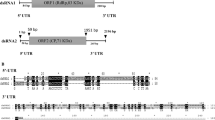Abstract
A novel chuvirus from a southern green stink bug (Nezara viridula) was identified by RNA sequencing in this study and was tentatively named “Ningbo southern green stink bug chuvirus 1” (NBSGSBV-1). The complete genome sequence of NBSGSBV-1 consists of 11,375 nucleotides, and the genome was found to be circular by ‘around-the-genome’ reverse transcription polymerase chain reaction (RT-PCR) and Sanger sequencing. Three open reading frames (ORFs) were predicted in the NBSGSBV-1 genome, encoding a large polymerase protein (L protein), a glycoprotein (G protein), and a nucleocapsid protein (N protein). A phylogenetic tree was constructed based on all of the currently available RNA-dependent RNA polymerase amino acid sequences of viruses of the family Chuviridae, and NBSGSBV-1 was found to cluster together with Sanya chuvirus 2 and Hubei odonate virus 11, indicating that NBSGSBV-1 might belong to the genus Odonatavirus. Five conserved sites were identified in the L proteins of NBSGSBV-1 and other chuviruses. The abundance and characteristics of the NBSGSBV-1-derived small interfering RNAs suggested that NBSGSBV-1 actively replicates in the host insect. To the best of our knowledge, this is the first report of a chuvirus identified in a member of the insect family Pentatomidae. The discovery and characterization of NBSGSBV-1 will help us to understand the diversity of chuviruses in insects.


Similar content being viewed by others
References
Edgar RC, Taylor J, Lin V, Altman T, Barbera P, Meleshko D, Lohr D, Novakovsky G, Buchfink B, Al-Shayeb B, Banfield JF, de la Pena M, Korobeynikov A, Chikhi R, Babaian A (2022) Petabase-scale sequence alignment catalyses viral discovery. Nature 602:142–147
Li C-X, Shi M, Tian J-H, Lin X-D, Kang Y-J, Chen L-J, Qin X-C, Xu J, Holmes EC, Zhang Y-Z (2015) Unprecedented genomic diversity of RNA viruses in arthropods reveals the ancestry of negative-sense RNA viruses. Elife 4:e05378. https://doi.org/10.7554/eLife.05378
Niu J, Li XL, Wu YL, Sun QZ, Zhang W, Cao M, Wang JJ (2020) RNA virome screening in diverse but ecologically related citrus pests reveals potential virus-host interactions. J Invertebr Pathol 170:107329
Qin XC, Shi M, Tian JH, Lin XD, Gao DY, He JR, Wang JB, Li CX, Kang YJ, Yu B, Zhou DJ, Xu J, Plyusnin A, Holmes EC, Zhang YZ (2014) A tick-borne segmented RNA virus contains genome segments derived from unsegmented viral ancestors. Proc Natl Acad Sci U S A 111:6744–6749
Shi M, Lin XD, Tian JH, Chen LJ, Chen X, Li CX, Qin XC, Li J, Cao JP, Eden JS, Buchmann J, Wang W, Xu J, Holmes EC, Zhang YZ (2016) Redefining the invertebrate RNA virosphere. Nature 540:539–543
Cook S, Chung BY, Bass D, Moureau G, Tang S, McAlister E, Culverwell CL, Glucksman E, Wang H, Brown TD, Gould EA, Harbach RE, de Lamballerie X, Firth AE (2013) Novel virus discovery and genome reconstruction from field RNA samples reveals highly divergent viruses in dipteran hosts. PLoS ONE 8:e80720
Todd JJA (1989) Ecology and behavior of Nezara viridula. Annu Rev Entomol 34:273–292
Panizzi A, Lucini T (2016) What happened to Nezara viridula (L.) in the Americas? Possible reasons to explain populations decline. Neotrop Entomol 45:619–628
Miller L, Rose H, McDonald F (1978) The effects of damage by the green vegetable bug, Nezara viridula (L.) on yield and quality of soybeans. Aust J Entomol 16:421–426
Leskey TC, Hamilton GC, Nielsen AL, Polk DF, Rodriguez-Saona C, Bergh JC, Herbert DA, Kuhar TP, Pfeiffer D, Gp D (2012) Pest status of the brown marmorated stink bug, Halyomorpha halys in the USA. Outlooks Pest Manag 23:218–226
Williamson C, Von Wechmar M (1992) Two novel viruses associated with severe disease symptoms of the green stinkbug Nezara viridula. J Gen Virol 73:2467–2471
Susevich ML, Reynaldi FJ, Marti GA, Echeverría MG (2019) Primer hallazgo del Virus de la Parálisis Aguda Israelí (IAPV) en Nezara viridula (Hemiptera: Pentatomidae). Rev Soc Entomol Argentina 78:1–5
Grabherr MG, Haas BJ, Yassour M, Levin JZ, Thompson DA, Amit I, Adiconis X, Fan L, Raychowdhury R, Zeng Q (2011) Full-length transcriptome assembly from RNA-Seq data without a reference genome. Nat Biotechnol 29:644–652
Nguyen L-T, Schmidt HA, Von Haeseler A, Minh BQ (2015) IQ-TREE: a fast and effective stochastic algorithm for estimating maximum-likelihood phylogenies. Mol Biol Evol 32:268–274
Kozlov AM, Darriba D, Flouri T, Morel B, Stamatakis A (2019) RAxML-NG: a fast, scalable and user-friendly tool for maximum likelihood phylogenetic inference. Bioinformatics 35:4453–4455
Darriba D, Posada D, Kozlov AM, Stamatakis A, Morel B, Flouri T (2020) ModelTest-NG: a new and scalable tool for the selection of DNA and protein evolutionary models. Mol Biol Evol 37:291–294
Li J, Andika IB, Shen J, Lv Y, Ji Y, Sun L, Chen J (2013) Characterization of rice black-streaked dwarf virus-and rice stripe virus-derived siRNAs in singly and doubly infected insect vector Laodelphax striatellus. PLoS ONE 8:e66007
Acknowledgements
This work was supported by the National Natural Science Foundation of China (U20A2036) and Ningbo Science and Technology Innovation 2025 Major Project (2019B10004).
Author information
Authors and Affiliations
Corresponding author
Ethics declarations
Compliance with ethical standards
The authors declare no conflict of interest.
Ethics statement
No experimental work with humans was done in this study.
Additional information
Handling Editor: T. K. Frey .
Publisher's Note
Springer Nature remains neutral with regard to jurisdictional claims in published maps and institutional affiliations.
Supplementary Information
Below is the link to the electronic supplementary material.
705_2022_5560_MOESM2_ESM.tif
Supplementary Fig. S2 Multiple sequence alignment and locations of motifs in the L proteins of NBSGSBV-1 and closely related chuviruses. Five conserved motifs were identified using MEME, and the conserved sites are indicated by red boxes
Rights and permissions
Springer Nature or its licensor holds exclusive rights to this article under a publishing agreement with the author(s) or other rightsholder(s); author self-archiving of the accepted manuscript version of this article is solely governed by the terms of such publishing agreement and applicable law.
About this article
Cite this article
Ren, PP., Ye, ZX., Wang, SN. et al. Complete genome analysis of a novel chuvirus from a southern green stink bug (Nezara viridula). Arch Virol 167, 2423–2427 (2022). https://doi.org/10.1007/s00705-022-05560-1
Received:
Accepted:
Published:
Issue Date:
DOI: https://doi.org/10.1007/s00705-022-05560-1




